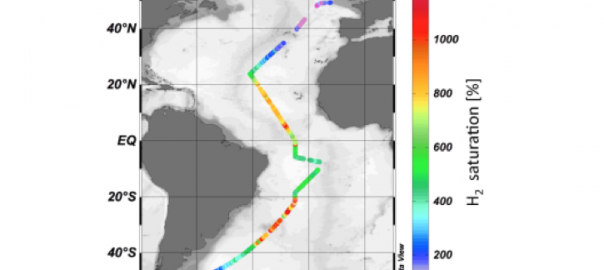The nitrogen cycle is fundamental to Earth’s biogeochemistry. Yet major quantitative uncertainties remain, particularly regarding the global oceanic nitrogen fixation rate.
Hydrogen is produced during nitrogen fixation and will become supersaturated in surface waters if there is net release from nitrogen fixing bacteria (diazotrophs). Ocean surveys of hydrogen supersaturation therefore have the potential to illustrate the spatial and temporal distribution of nitrogen fixation and to guide the far more onerous but quantitative methods for measuring it.
Mick Follows and Stephanie Dutkiewicz contribute to a study (Moore et al., 2014) presenting the first transect of high resolution measurements of hydrogen supersaturations in surface waters along a meridional 10,000 km cruise track through the Atlantic.
Assuming the primary source of excess hydrogen is nitrogen fixation with a hydrogen release ratio similar to Trichodesmium, Moore et al’s hydrogen measurements suggest similar rates of fixation in the North and South Atlantic, roughly consistent with modeled fixation rates.
These hydrogen-based results did not agree with previously measured rates however, which had suggested lower nitrogen fixation in the south. However several models (including that of Follows and Dutkiewicz) also suggested comparable values in North and South Atlantic. Bottom line – as the title suggests – measurements of hydrogen super-saturation in the western South Atlantic, at least, suggest nitrogen fixation there may be substantially underestimated.
Publication
Moore, R.M., M. Kienast, M. Fraser, J. Cullen, C. Deutsch, S. Dutkiewicz, M.J. Follows, and C.J. Somes (2014), Substantial underestimation of nitrogen fixation suggested by hydrogen supersaturations in the Atlantic, Journal of Geophysical Research - Oceans , 119, 4340-4350, doi: 10.1002/2014JC010017.
